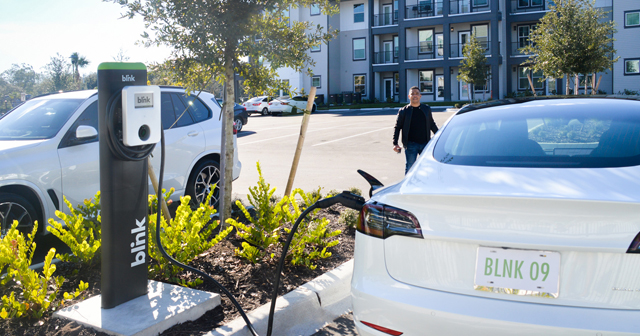EV Charging is no longer a ‘nice to have’ amenity for shopping center owners.
A “symbiotic” relationship has emerged between retailers, landlords and charging providers as the race among automakers to electrify their fleets, coupled with strong regulatory interest and investment at the state and local level, push more drivers to electric vehicles.
An estimated 630,000 new EVs were sold last year alone in the United States, and two of the five top-selling cars in California are Teslas (the Model 3 and the Model Y). And at a panel discussion this week at ICSC Western States in San Diego, a panel of CRE and EV industry experts agreed that electric vehicle charging stations are no longer a “nice to have” in areas with high EV utilization rates.
Mike Battaglia, Senior Vice President of Sales and Business Development at Blink Charging, said he spent a good portion of his career at JD Power, where he frequently met with automakers who “within five minutes” would steer the conversation to electric vehicles.
“All they wanted to talk about was electrification. It didn’t matter what the original topic was,” he said. “So one of the things I was able to see were product plans. It did not matter and it doesn’t matter who’s in office, what the political winds are, none of that. All the automakers have already decided that the tech of the future is electric. They’re already moving down that road.”
Calling the number of EVs hitting the market this year and going forward “staggering,” Battaglia says the electrification revolution is “definitely being driven” by automakers and their plans for growth.
For shopping centers, EVs provide the ability to monetize parking space, becoming an onsite asset in a new way. And EV charging “also draws a very nice demographic of customer,” Battaglia said. “You look at the demographic of a Tesla customer and it’s awesome. You want that customer coming to your center.”
Edie Trott, senior marketing manager at NewMark Merrill Companies, comes at the issue from the landlord side. She says that when NewMark Merrill started talking about adding EV charging to its properties, they viewed it as an amenity for shoppers and for something they could bring to the surrounding community as a service. There’s now also compelling data about how much people spend at their centers while they’re charging.
“Between providing a service for existing customers and bringing new customers to shop at your retailers, it’s really a win-win,” Trott said.
Landlords should also consider what level of charging they want to offer, panelists agreed, and that determination is dependent on a variety of factors. For NewMark Merrill, “it was really only Level 3, because that’s where the EV market is going,” Trott said. “People want the convenience of that fast full charge. That was really important that we provide the top product that was available.”
But Battaglia of Blink Charging said the company offers both Level 2 and 3 charging, and urges landlords to “follow the stats.”
“An estimated eighty percent of all charging events are going to happen at home,” he said. “You don’t want to create such a fast charge that all of a sudden you’ve short circuited that retail experience. You have to get this mix right of level 2 versus level 3 and it’s an art form. It’s not strictly science… the grid could never handle if everything was Level 3.”
Utilization rates also matter, said Nicole Lewandowski of EVgo, and factor into determining an appropriate charging level.
“EVgo’s average investment is between half a million and a million dollars per site,” she said. “If you have the most beautiful shopping center in South Dakota, today is not the day for me to invest a million dollars. If you’re in LA, call me up — we’ll have that utilization. But that’s today; South Dakota will eventually will come, it’s just not a great investment for EVgo today. If you’re in a low utilization area, level 2 probably works.”
To read the original article, please visit https://www.globest.com/2022/10/03/how-shopping-centers-are-getting-those-tesla-drivers-into-their-stores/
